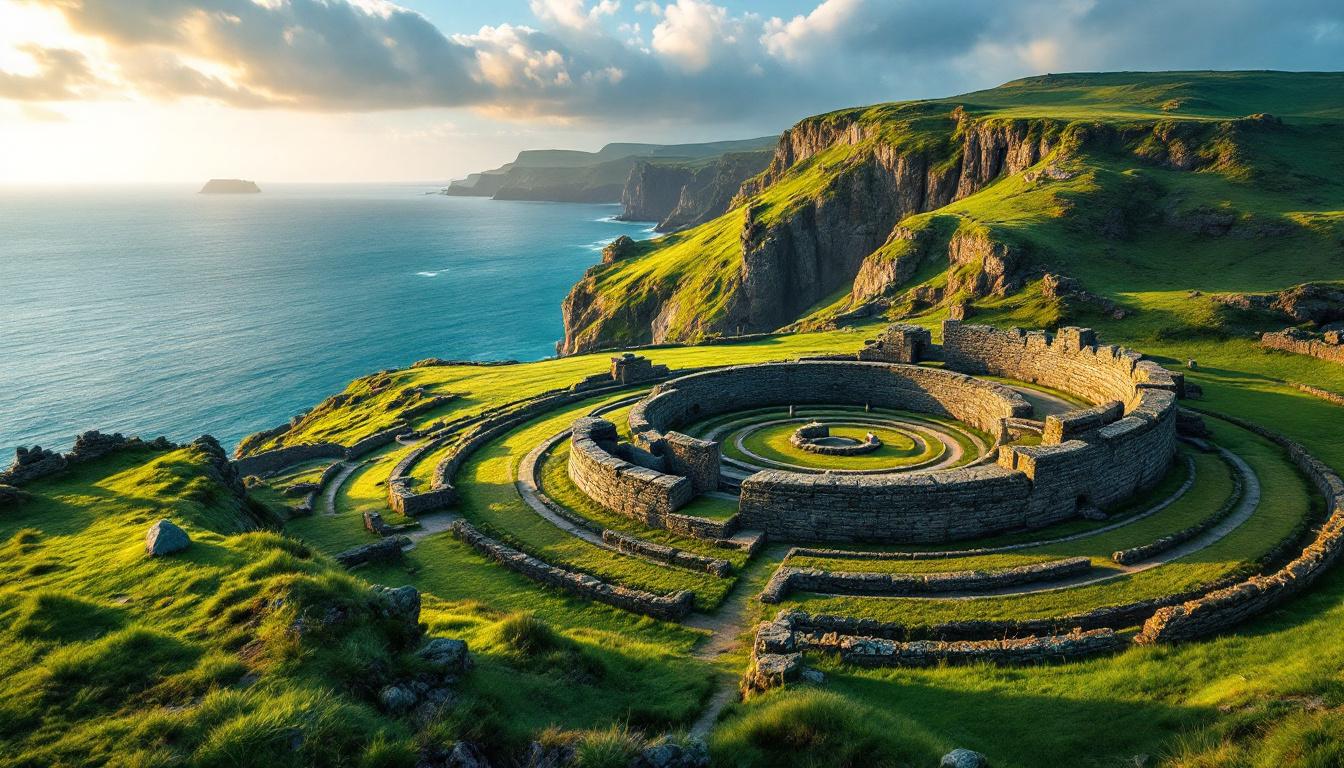Standing on the windswept cliffs of Inis Mór, watching Atlantic waves crash 300 feet below while ancient stones whisper in Gaelic around me, I realized I’d found something extraordinary. This is the only place in Ireland where a 1,500-year-old Irish-speaking community still guards Europe’s most dramatically preserved prehistoric cliff fort.
While tourists crowd the Cliffs of Moher for Instagram shots, Dún Aonghasa offers something infinitely rarer: authentic immersion in living Celtic culture combined with archaeological magnificence that predates Christ by over a millennium.
The ferry from Rossaveal carries you away from modern Ireland into something timeless. Within 40 minutes, you’re stepping onto an island where Irish remains the daily language and ancient traditions survive not as tourist performances, but as genuine community life.
The cliff fort that defied Roman conquest
Prehistoric engineering that still amazes archaeologists
Dún Aonghasa spans 14 acres across four concentric stone walls, with the outer ramparts containing over 6,500 tonnes of precisely fitted limestone blocks. The fort’s chevaux-de-frise defense system – thousands of jagged stone spikes jutting from the ground – remains unique among European prehistoric sites, designed to stop cavalry charges that never came to this Atlantic outpost.
The dramatic cliff edge location that takes your breath away
Perched on a 300-foot vertical cliff, the fort’s innermost wall simply ends at the precipice, creating one of Europe’s most heart-stopping archaeological sites. Standing where Bronze Age warriors once watched for approaching boats, you’ll understand why this location was chosen for defense – and why it’s survived 3,000 years of Atlantic storms.
Living Gaeltacht culture that tourism hasn’t touched
The last community where Irish flows naturally in daily conversation
Unlike mainland Gaeltacht regions where Irish often feels preserved for visitors, Inis Mór’s 900 residents conduct business, raise children, and share gossip in their native tongue. Evening seisiún (music sessions) in local pubs feature conversations that seamlessly switch between Irish and English, creating an authentically bilingual atmosphere impossible to replicate elsewhere.
Traditional crafts that connect you to ancient island life
Watch islanders build traditional currachs – canvas boats identical to those used 2,000 years ago – using techniques passed down through generations. The famous Aran sweater patterns aren’t tourist souvenirs here; they’re working garments knitted by women whose families have lived on these stones for centuries, each pattern telling stories of specific island families.
Access advantages that reward the adventurous
Natural crowd control that preserves the authentic experience
The 40-minute ferry journey from Rossaveal naturally limits visitor numbers, ensuring you’ll often have Dún Aonghasa’s ramparts to yourself. Unlike overcrowded mainland attractions, the island’s isolation means even summer visits feel intimate and personal, with local guides speaking Irish while explaining archaeological mysteries.
Cost benefits that make authentic Ireland affordable
Island accommodation averages €90 per night for authentic B&Bs where breakfast conversations happen in Irish. Fresh seafood meals cost €15-20, far less than equivalent experiences in Galway or Dublin. Bike rentals at €10 daily provide the perfect pace for exploring stone walls that divide the landscape into thousands of tiny fields, each one hand-built by generations of islanders.
August timing that maximizes cultural immersion
Perfect weather window for cliff fort exploration
August delivers 18-hour daylight and comfortable 20°C temperatures, ideal for spending entire days exploring the fort’s multiple defensive rings. Atlantic breezes keep conditions pleasant for hiking, while calm seas ensure reliable ferry service – crucial for reaching this remote cultural treasure.
Summer festival season that reveals authentic island traditions
August brings traditional races of currachs and evening céilí dancing where visitors join locals in authentic celebrations. The island’s small scale means you’re not watching performances – you’re participating in genuine community events where Irish songs echo off ancient stones and conversations with locals reveal family histories stretching back centuries.
Frequently asked questions about Inis Mór
How do I reach Inis Mór from major Irish airports?
From Dublin or Shannon airports, take buses or trains to Galway, then connect to Rossaveal for the 40-minute ferry journey. Multiple daily departures run from April through October, with reduced winter schedules.
Is Irish language knowledge required for visiting?
English is widely spoken, but learning basic Irish phrases like “Dia dhuit” (hello) creates instant connections with locals who genuinely appreciate visitors’ cultural curiosity and respect.
What makes Dún Aonghasa different from other Irish historical sites?
Dún Aonghasa combines prehistoric archaeology with living culture – you’ll explore ancient stones while hearing the same language spoken by their builders, creating an unmatched connection to Ireland’s authentic past.
This island offers what mass tourism destroys elsewhere: genuine cultural immersion where ancient traditions survive naturally, not as museum displays. Visit respectfully, learn a few Irish words, and experience the only place where Europe’s most magnificent cliff fort still pulses with the heartbeat of its original Celtic culture.
